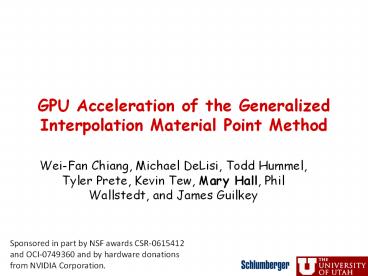GPU Acceleration of the Generalized Interpolation Material Point Method PowerPoint PPT Presentation
Title: GPU Acceleration of the Generalized Interpolation Material Point Method
1
GPU Acceleration of the Generalized Interpolation
Material Point Method
- Wei-Fan Chiang, Michael DeLisi, Todd Hummel,
Tyler Prete, Kevin Tew, Mary Hall, Phil
Wallstedt, and James Guilkey
Sponsored in part by NSF awards CSR-0615412 and
OCI-0749360 and by hardware donations from NVIDIA
Corporation.
2
Outline
- What is Material Point Method and Generalized
Interpolation Material Point Method? - Suitability for GPU Acceleration
- Implementation Challenges
- Inverse mapping from grids to particles (global
synchronization) - I/O in sequential implementation
- Experimental Results
- Looking to the future
- Programming Tools and Auto-tuning
3
Rigid, Soft Body and Fluid Simulations
- Breadth of applications
- fluids and smoke in games, astrophysics
simulation, oil exploration, and molecular
dynamics - MPM Part of Center for the Simulation of
Accidental Fires and Explosions (C-SAFE) software
environment
Tungsten Particle Impacting sandstone
Compaction of a foam microstructure
4
The Material Point Method (MPM)
1. Lagrangian material points carry all state
data (position, velocity, stress, etc.)
2. Overlying mesh defined
3. Particle state projected to mesh, e.g.
4. Conservation of momentum solved on mesh
giving updated mesh velocity and (in
principal) position. Stress at particles
computed based on gradient of the mesh
velocity.
5. Particle positions/velocities updated from
mesh solution.
6. Discard deformed mesh. Define new mesh and
repeat
5
Approach
- Start with sequential library implementation of
MPM and GIMP - And descriptions of parallel OpenMP and MPI
implementations - Profiling pinpointed key computations
(updateContribList and advance, gt99) - Two independent implementations (2-3 person
teams) - Some other aspects of mapping
- Makes heavy use of C templates
- Gnuplot used for visualization
6
Key Features of MPM and GIMP Computation
- Large amounts of data parallelism
- Particles mapped to discretized grid
- Compute contribution of particles to grid nodes
(updateContribList) - Compute ltforce, velocity, acceleration, stressgt
operations on grid nodes (advance) - Each time step, the particles are moving
- Compute stresses and recompute mapping
- Periodically, visualize or store results
7
Overview of Strategy for CUDA Implementation
- Partition particle data structure and mapping to
grid across threads - Build an inverse map from grid nodes to particles
- Requires global synchronization
- Later phase partitions grid across threads
- Two implementations differ in strategy for this
inverse map - V1 Sort grid nodes after every time step
- V2 Replicate inverse map, using extra storage to
avoid hotspots in memory (focus)
8
Global Synchronization for Inverse Map (CUDA
Particle Project)
- __device__ void addParticleToCell(int3 gridPos,
uint index, uint gridCounters, uint gridCells) - // calculate grid hash
- uint gridHash calcGridHash(gridPos)
- // increment cell counter using atomics
- int counter atomicAdd(gridCountersgridHash
, 1) - counter min(counter, params.maxParticlesPerCe
ll-1) - // write particle index into this cell
(uncoalesced!) - gridCellsgridHashparams.maxParticlesPerCell
counter index
index refers to index of particle gridPos
represents grid cell in 3-d space gridCells is
data structure in global memory for the inverse
mapping What this does Builds up gridCells as
array limited by max particles per grid
atomicAdd gives how many particles have already
been added to this cell
9
Optimized Version Replicate gridCounters to
avoid Contention
Threads computing Inverse mapping
Threads computing Inverse mapping
Ta
Tb
Tc
Ta
Tb
Tc
atomicAdd operations
atomicAdd operations
gcxp
gcyp
gczp
gcx1
gcy1
gcz1
gcx0
gcy0
gcz0
gcx
gcy
gcz
replicated gridCounter (global memory)
gridCounter, one elt per grid node (global memory)
- Results of this optimization
- 2x speedup on updateContribList
10
Summary of Other Optimizations
- Global memory coalescing
- gridHash and gridCounters organization
- Use of float2 and float4 data types
- CUDA Visual Profiler pinpointed these!
- Maintain data on GPU across time steps
- Fuse multiple functions from sequential code into
single, coarser grained GPU kernel - Replace divides by multiples of inverse and cache
11
Experiment Details
- Architectures
- Original Intel Core2 Duo E8400 (3.00 GHz)
- CUDA nVIDIA GeForce 9600 GT (8 SMs)
- Input data set
Cell Grid Nodes Particles
32 1,352 2,553
64 5,356 9,177
96 12,012 19,897
12
Results on Key Computations
- All results use 128 threads
- Speedups of 12.5x and 6.6x, respectively, over
sequential implementation
13
Overall Speedup Results
- No output, speedup of 10.7x
- With output, speedup only 3.3x
- Obvious future work Open GL for visualization
14
Shifting Gears Programmability and Auto-tuning
- Midterm extra credit question
- If you could invest in tool research for GPUs,
in what areas would you like to see progress? - Tools
- Assistance with partitioning across
threads/blocks - Assistance with selecting numbers of
threads/blocks - Assistance with calculating indexing relative to
thread/block partitioning
15
Auto-Tuning Compiler
16
Current Research Activity
- Automatically generate CUDA from sequential code
and transformation script, with
CUDAize(loop,TI,TJ,kernnm) - Advantages of auto-tuning
- Tradeoffs between large number of threads to hide
latency and smaller number to increase reuse of
data in registers - Detect ordering sensitivities that impact
coalescing, bank conflicts, etc. - Evaluate alternative memory hierarchy
optimizations - Addresses challenges from earlier slide
- Correct code generation, including indexing
- Auto-tuning to select best thread/block
partitioning - Memory hierarchy optimizations and data movement
17
Summary
- Three areas of improvement for MPM/GIMP
- Used single precision, which may not always be
sufficiently precise - Wanted more threads but constrained by register
limits - OpenGL visualization of results
- Newer GPUs and straightforward extensions
ameliorate these challenges - Future work on programmability and auto-tuning

